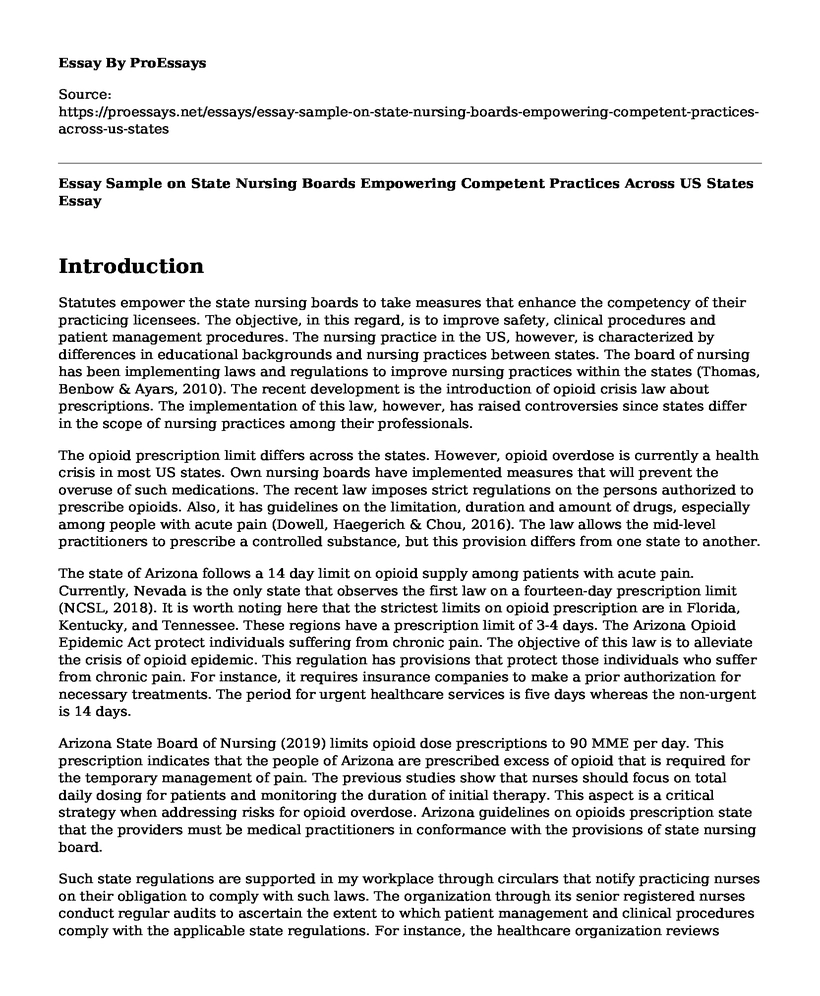Introduction
Statutes empower the state nursing boards to take measures that enhance the competency of their practicing licensees. The objective, in this regard, is to improve safety, clinical procedures and patient management procedures. The nursing practice in the US, however, is characterized by differences in educational backgrounds and nursing practices between states. The board of nursing has been implementing laws and regulations to improve nursing practices within the states (Thomas, Benbow & Ayars, 2010). The recent development is the introduction of opioid crisis law about prescriptions. The implementation of this law, however, has raised controversies since states differ in the scope of nursing practices among their professionals.
The opioid prescription limit differs across the states. However, opioid overdose is currently a health crisis in most US states. Own nursing boards have implemented measures that will prevent the overuse of such medications. The recent law imposes strict regulations on the persons authorized to prescribe opioids. Also, it has guidelines on the limitation, duration and amount of drugs, especially among people with acute pain (Dowell, Haegerich & Chou, 2016). The law allows the mid-level practitioners to prescribe a controlled substance, but this provision differs from one state to another.
The state of Arizona follows a 14 day limit on opioid supply among patients with acute pain. Currently, Nevada is the only state that observes the first law on a fourteen-day prescription limit (NCSL, 2018). It is worth noting here that the strictest limits on opioid prescription are in Florida, Kentucky, and Tennessee. These regions have a prescription limit of 3-4 days. The Arizona Opioid Epidemic Act protect individuals suffering from chronic pain. The objective of this law is to alleviate the crisis of opioid epidemic. This regulation has provisions that protect those individuals who suffer from chronic pain. For instance, it requires insurance companies to make a prior authorization for necessary treatments. The period for urgent healthcare services is five days whereas the non-urgent is 14 days.
Arizona State Board of Nursing (2019) limits opioid dose prescriptions to 90 MME per day. This prescription indicates that the people of Arizona are prescribed excess of opioid that is required for the temporary management of pain. The previous studies show that nurses should focus on total daily dosing for patients and monitoring the duration of initial therapy. This aspect is a critical strategy when addressing risks for opioid overdose. Arizona guidelines on opioids prescription state that the providers must be medical practitioners in conformance with the provisions of state nursing board.
Such state regulations are supported in my workplace through circulars that notify practicing nurses on their obligation to comply with such laws. The organization through its senior registered nurses conduct regular audits to ascertain the extent to which patient management and clinical procedures comply with the applicable state regulations. For instance, the healthcare organization reviews patient records to determine aspects such as dose prescriptions and thereby take corrective measures where it is not in line with state regulations.
Conclusion
The scope of nursing practice differs in states. It implies that a range of responsibilities, roles, and functions that practicing nurses have the authority to perform vary across the US. States differ on the extent to which they grant their nursing professionals a full practice authority. Some states, for instance, allow their nurses to work independently without the oversight of a physician. Watson Hillman (2010) argued that the practices of registered nurses are expanding as they gain autonomy from the modern healthcare delivery system. This variation has an impact on professional nurses since it does not give them the freedom to utilize their skill-set, knowledge and educational training.
References
Arizona State Board of Nursing. (2019). Opioids Prescribing Requirements. Retrieved April 26, 2019, from https://www.azbn.gov/board/news-events/arizona-opioid-prescribing-guidelines-released/url/
Dowell, D., Haegerich, T. M., & Chou, R. (2016). CDC Guideline for Prescribing Opioids for Chronic Pain-the United States, 2016. JAMA, 315(15), 1624. DOI: 10.1001/jama.2016.1464.
NCSL- National Conference of State Legislators. (2018). Prescribing Policies: States Confront Opioid Overdose Epidemic. NCSL website. Retrieved April 26, 2019, from http://www.ncsl.org/research/health/prescribing-policies-states-confront-opioid-overdose-epidemic.aspx/url/. Published October 31, 2018.
Thomas, M. B., Benbow, D. A., & Ayars, V. D. (2010). Continued Competency and Board Regulation: One State Expands Options. The Journal of Continuing Education in Nursing, 41(11), 524-528. DOI: 10.3928/00220124-20100701-04.
Watson, E., & Hillman, H. (2010). Advanced practice registered to nurse: licensure, education, Scope of practice, and liability issues. Journal of legal nurse consulting, 21(3), 25-29.
Cite this page
Essay Sample on State Nursing Boards Empowering Competent Practices Across US States. (2023, Jan 09). Retrieved from https://proessays.net/essays/essay-sample-on-state-nursing-boards-empowering-competent-practices-across-us-states
If you are the original author of this essay and no longer wish to have it published on the ProEssays website, please click below to request its removal:
- Brief Synopsis of the Article on Patient-Centered Care
- Communication in Public Health. Essay Example.
- Nutritional Benefits for Breast Milk Paper Example
- Modern Medicine: Improved Lifespans and Euthanasia Debate - Essay Sample
- Essay Example on End-of-Life Simulation: A Vital Nursing Career Experience
- Research Paper on Hysterectomy: Reasons, Considerations & Complications
- Paper Example on Core Temp & Cardiovascular Drift: Prolonged Exercise Implications







